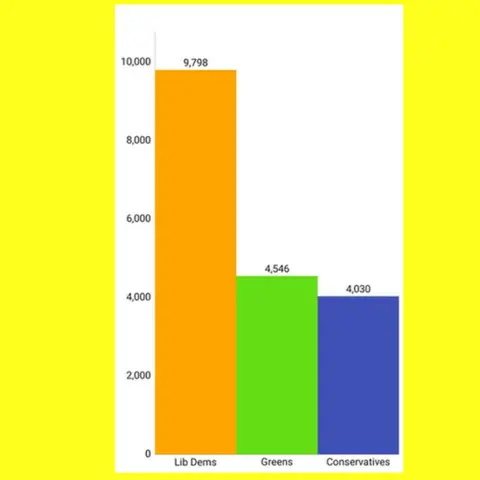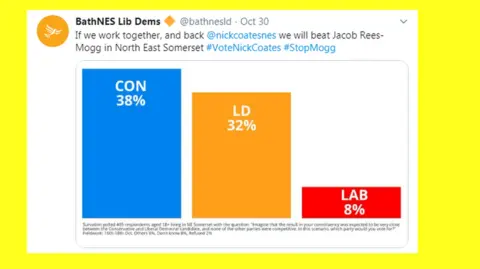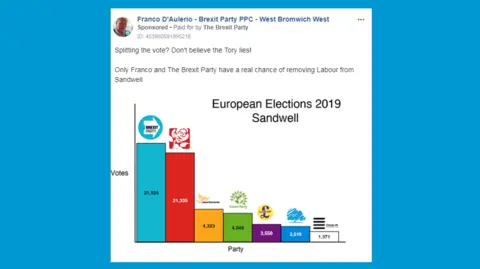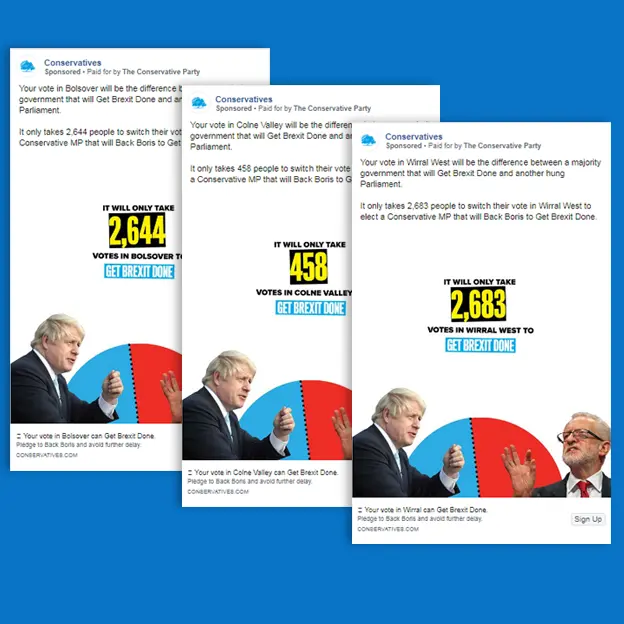General election 2019: Are Lib Dem bar charts and posts on tactical voting misleading people?
 Getty Images
Getty ImagesThere's a wealth of election leaflets and ads encouraging tactical voting, but are some based on misleading information?
Ads and leaflets doing the rounds online and off are trying to suggest a close contest in a particular constituency, and that only a vote for the party behind the advertising can prevent the return of the sitting MP.
Many of the complaints about this tactic on social media seem to be targeted at the Liberal Democrats.
Using partial data
In North Tyneside, a graph on the 2019 European elections implies the Lib Dems received a majority of the votes, way ahead of the other parties.
 Liberal Democrats
Liberal DemocratsBut it omits the fact the Lib Dems were beaten by both Labour and the Brexit Party.
The scale only goes up to 10,000, when the highest number of votes received, by the Brexit Party, was 17,944.
European Parliament election results are also not really comparable to general elections.
The Lib Dem Bath and North East Somerset association, meanwhile, shared a much mocked graph on Facebook that made it look like their party was breathing down the Conservatives' necks.
 Liberal Democrats
Liberal DemocratsRead the small print, however, and it turns out this reflects a Survation poll of only 405 people asked the leading question: "Imagine that the result in your constituency was expected to be very close between the Conservative and Liberal Democrat candidate and none of the other parties were competitive. In this scenario, which party would you vote for?"
What does this say about the upcoming general election? Maybe a bit about how many hardcore Labour supporters were polled in this seat - and that the Conservatives are still ahead in the polls - but not much about how much genuine support there is for the Lib Dems.
In the 2017 general election, the Conservatives won about 54% of the vote in the constituency, Labour won about 35% and the Lib Dems came in a not very close third with about 8%.
Professor Jane Green at the University of Oxford said that "the perception that the Liberal Democrats are a viable party is very important to them locally," as the view of them as a "contender" would be more likely to make people vote for them tactically.
Using local election data
A Lib Dem leaflet distributed in Totnes, sent to us by Twitter user Gareth Wolf, says the 2019 district elections in the area show "only the Lib Dems can beat the Tories" at the general election.
But while they can provide useful pointers, local elections are not a very good indication of what might happen in a general election.
As pollsters YouGov put it in 2017: "People vote differently at local elections. They have lower turnout, some people will vote based on local issues or their local councillor."
And unlike in local elections, while general elections may see people voting in part because they like their local MP, they will also have an eye to the leader this vote could install in No 10.
Things can change a lot in a couple of years - but it's generally best to use the last general election results as a baseline.
A Liberal Democrat spokesperson said, "Bar charts reflect a wide range of polling scenarios, in large part dependent on local context. The source of the data will always be made clear on any election literature published by the Liberal Democrats. "
The Green Party has also used local election data, while the Labour Party has mainly stuck to showing results from 2017 - or more commonly attacking the record of the Conservative government.
Both the Lib Dems and the Brexit Party have also used EU election results to make claims about the potential for success in a general election.
While many of the Lib Dems adverts are targeted to Remain-voting Tory seats, the Brexit Party is training its sights on Labour Leave voters.
And both hope to present themselves as the only alternative for voters wanting to achieve their desired Brexit result.
 AFP
AFPIn Putney, the Lib Dems said YouGov polling put them neck-and-neck with the Conservatives and that Labour "can't win".
But YouGov has not done any polling in Putney.
Instead, it turned out, the figures quoted had come from an organisation called Flavible.
And its founder released a statement saying some Liberal Democrat candidates had "either themselves misinterpreted the data or intentionally mislabelled the data for political advantage".
"I do not think a single projection of a single seat based on a single poll is acceptable as campaign literature."
In the 2017 general election, the Conservatives and Labour won 44 and 41% of the vote respectively.
While the Conservative Party, like Labour, has mostly steered clear of bar charts, it's tried to send a similar message in a number of Facebook ads targeted largely at Labour-held Leave-voting seats.
One series of ads, seen by an estimated 1.4 million people, claimed to show them how many votes in their area it would take to "get Brexit done".
 Conservatives
ConservativesThey show the differences between the Labour and Conservative share of the vote (although in some cases, they got the vote share slightly wrong, as Channel 4 Fact Check reported).
The ads suggest this number of votes would be "the difference between a majority government that will Get Brexit Done and another hung Parliament".
But they fail to factor in any voters switching away from the Conservatives, or other parties' voters switching to Labour, in their sums.
Clicking on the ad takes you to a page that invites you to share your data with the party through a form headed: "Add your name to Back Boris and Get Brexit Done".

These charts were found by:
- going through all of the parties' paid-for adverts on Facebook's ad library
- using the non-partisan website Election Leaflets which asks people to send in leaflets they've had through their doors
- Monitoring by the BBC's regional teams
- Ads flagged up to BBC Reality Check by readers
This isn't an exhaustive analysis of all the ads out there - if we missed any, send them our way.



